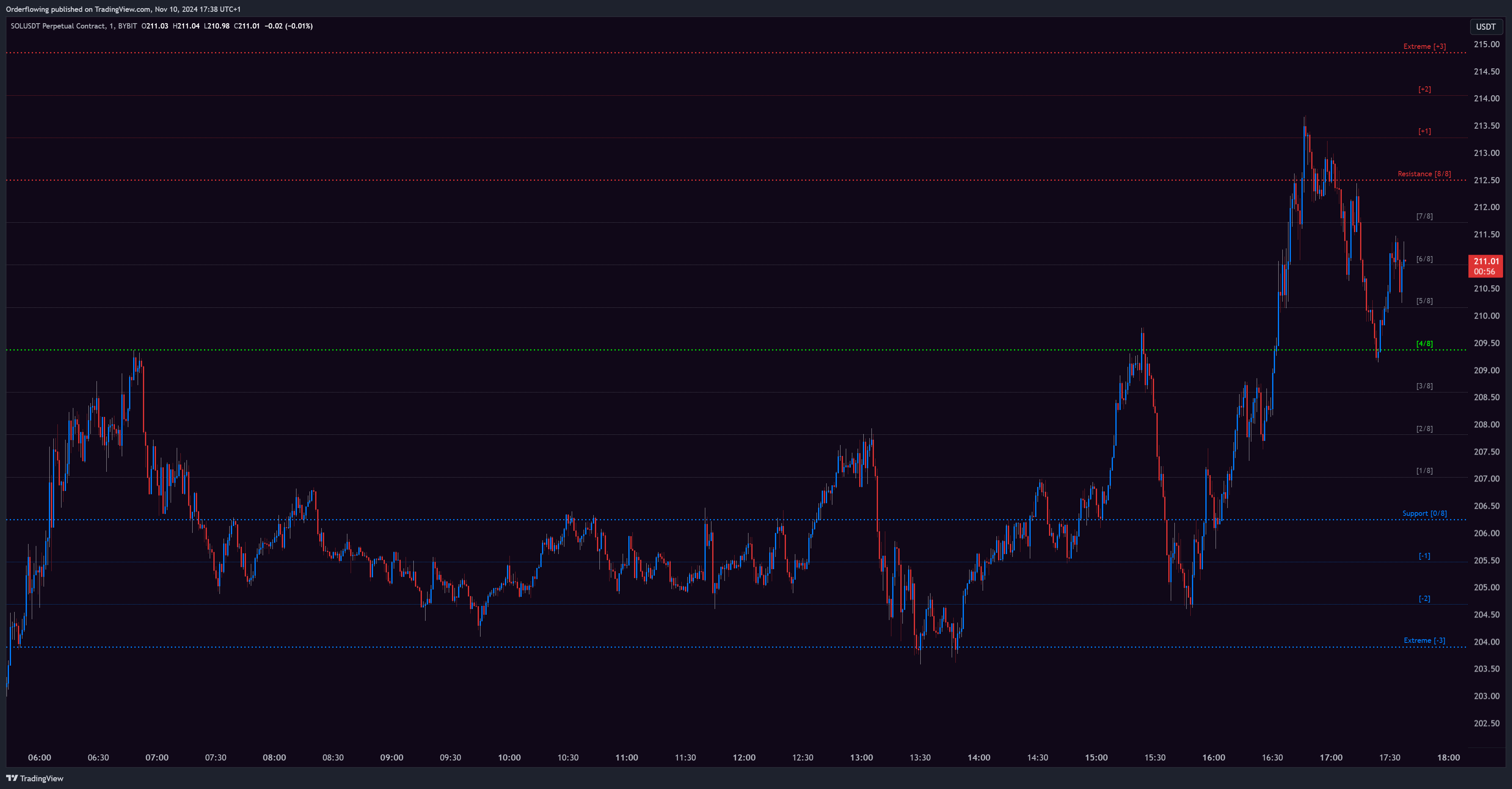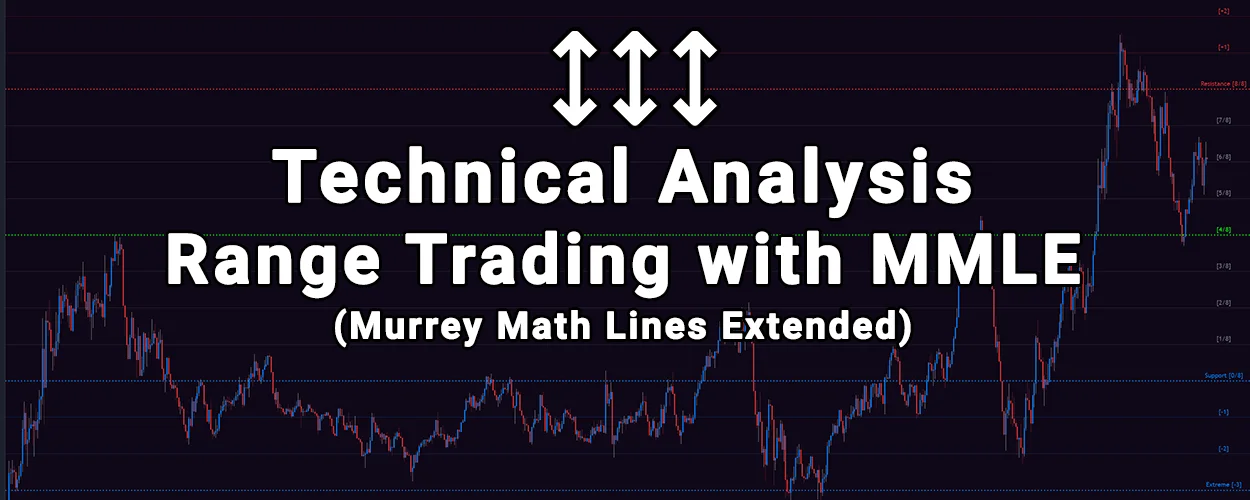Murrey Math Lines give traders a structured map of the market, making it easier to spot the natural flow of price and anticipate potential turning points.
Introduction
The Murrey Math Lines Extended (MMLE) Indicator is a tool that helps traders to approach range trading with precision. Based on the Murrey Math Trading System, it helps identify critical support and resistance levels and visualize price behavior within structured boundaries.
The Murrey Math Approach to Range Trading
Murrey Math Levels simplify the complex principles introduced by W.D. Gann, using a structured approach to price action that divides market movements into eighths. This framework helps traders understand when prices are overbought, oversold, or in balance. With key levels ranging from 0/8 to 8/8, traders can identify areas where price may consolidate, reverse, or break out.
Core Levels
0/8 and 8/8 Levels: Often mark extreme zones, where price may face significant resistance or support.
4/8 Level: Acts as the midpoint, representing equilibrium; breaking this level often signals a directional bias.
3/8 and 5/8 Levels: Define the core trading range, where price tends to oscillate around, providing ideal range-trading zones.
The Indicator’s Role in Range Trading
The MMLE takes traditional Murrey Math Lines a step further by adding extra extremity levels, expanding beyond the classic 0/8 to 8/8 range.
With additional levels at -1, -2, -3 on the downside and +1, +2, +3 on the upside, MMLE captures the market’s total extremes.
Adaptive Support and Resistance
The indicator automatically recalculates these levels to stay aligned with current market conditions, providing dynamic support and resistance that adjusts to price shifts.
Multi-Timeframe Analysis
MMLE enables traders to view long-term support and resistance levels while working in shorter timeframes.
How to Use MMLE for Effective Range Trading
Range trading involves buying at support and selling at resistance within a defined price band. Here’s how MMLE levels can guide this approach:
Trading Between 3/8 and 5/8 Levels
These lines represent the upper and lower boundaries of the primary trading range. Prices often move back and forth between these levels, creating opportunities to enter long positions near 3/8 and short positions near 5/8.
MMLE helps visualize this range, making it easier to recognize when price is consolidating within these boundaries.
Reversal Trades at Extreme Levels (0/8 and 8/8)
The 0/8 and 8/8 levels mark the most significant support and resistance zones. Price reaching these extremes often signals overbought or oversold conditions, providing potential reversal points.
For range traders, these levels can be used to set up contrarian positions, entering short at 8/8 or long at 0/8, anticipating a reversal back towards the central range.
Pivot Levels for Breakout or Reversal (2/8 and 6/8)
The 2/8 and 6/8 lines serve as secondary pivot points. If price bounces off these levels, it indicates a potential return to the central range. On the other hand, a break of these lines can signal trend continuation.
Range traders can use these levels to adjust positions or set alerts for potential breakout or reversal opportunities.
The Educational Value of Murrey Math’s Range Framework
MMLE and Murrey Math Lines are educational frameworks that help traders understand market rhythm and structure. By interpreting price within the context of these fixed levels, traders can see markets as oscillating systems rather than just chaotic movements.
Building Intuition for Market Cycles
Murrey Math’s division of price action into structured segments (octaves) trains traders to recognize recurring patterns. As a trader grows familiar with these levels, they begin to intuitively sense when price is likely to reverse, consolidate, or break out.
Encouraging Disciplined Trading
Trading with MMLE requires patience and adherence to specific levels, which encourages disciplined entries and exits. The method type approach reduces impulsive trades and focuses on prime trading setups.
Practical Example – Range Trading with Solana

Looking at the chart, we see MMLE levels guiding potential range trades.
We can observe that price action doesn’t spend much time oscillating within the typical trading range of 3/8 to 5/8.
Instead, the market shows a tendency to test the outer extremities and pivot around the midpoint, indicating a more volatile environment with larger price swings.
Extremes (0/8, 8/8, and Extended Levels)
The price frequently tests the extreme levels, such as 0/8 and 8/8, with occasional moves into the extended extremity levels at -1, -2, -3 on the downside and +1, +2, +3 on the upside.
These levels capture rare price extremes and serve as strong points for potential reversals. For example, a rejection at the 8/8 resistance level in this chart provided a clear shorting opportunity, with price reversing back down toward the central levels.
Also, price interactions around the -1 level signal potential support in an oversold condition, indicating the market’s propensity to test and respond to these extremes.
Midpoint Reversals at 4/8
The 4/8 level, which acts as the midpoint, serves as a critical pivot point on this chart. Price frequently interacts with the 4/8 level, pausing or reversing around it.
This behavior highlights 4/8 as a significant marker for observing potential trend shifts or consolidations, providing traders with a central reference point in the midst of larger price swings.
Movements Beyond the Primary Range
Instead of ranging between the 3/8 and 5/8 levels, the market shows broader swings that reach toward 0/8, 8/8, and beyond.
This suggests that the price is more inclined to make substantial moves between key support and resistance levels, rather than staying contained within a narrow range.
The outer levels in the MMLE framework, including the additional extremes, play a crucial role here, as they can be helpful to see where price is likely to reverse in a more volatile market setting.
In this scenario, MMLE levels help map out the broader range of price action, allowing traders to recognize key reversal zones at both the central and extreme levels.
This expanded range trading perspective provides essential guidance in capturing larger market movements rather than relying solely on the narrower 3/8 to 5/8 range.
Conclusion
The MMLE Indicator makes use of Murrey Math’s structured approach, making it a valuable tool for range trading. By giving traders a clear framework for support and resistance, MMLE helps us understand where price is more likely to bounce, stall, or reverse. It’s more than a tool but a way to see the market more clearly and trade with intention.
Explore More
Ready to build up your trading edge with our tools? Enjoy 7 Days Free Access on Any Subscription.
See the Indicators in Action & Get Instant Access
Further Reading and Resources
For more articles on technical analysis & indicators, check out these articles:
Technical Analysis: Volatility with Binary Fisher
